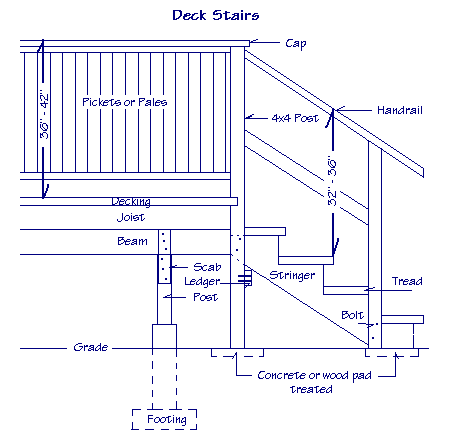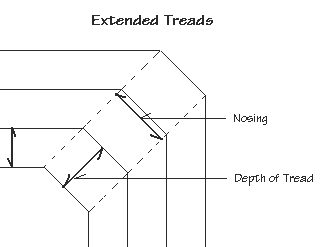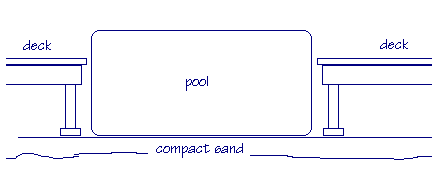
Building Confidence
| Volume 15 Issue 3 ISSN 1923-7162 |

Welcome to Dave's Shop Talk's Home Improvement Newsletter of questions from our members on their construction projects, a Tip of the Month and a home remodeling article, both from our website at http://daveosborne.com.
What's New
All 10 of our ebooks are now available for purchase. You can find them at http://daveosborne.com/books.php.
Tip of the Month
When pulling finish nails out of a piece of molding, pull them all the way through from the back using a pair of pliers to avoid scratching or splintering the face of the wood.
And a Bonus Tip:
If you are cutting on saw horses, it is a good idea to set the depth of the blade just below the surface you are cutting to avoid too much damage to the saw horses. It is also easier on the saw.
Ask Dave!
During the last few years answering questions on this website, I've retained a few good examples of different types of deck stairs.
Basic Deck Stairs
 Here is an example of the basic deck stairs off a raised backyard wood deck. Notice that the one piece 4x4 posts holding the deck stairs railing also carry the weight of the stair stringers. When attaching stair stringers to a backyard wood deck with only a 2x6 box joist, there usually is nothing to attach the stair stringers to. Here the stair stringer is bolted to the posts and a ledger board is installed under the stair stringer for those with a longer run. Either pressure treated wood or concrete pads are shown under the posts and bottom stair of the stair stringer, rather than having the stair stringers and posts just sitting on the ground.
Here is an example of the basic deck stairs off a raised backyard wood deck. Notice that the one piece 4x4 posts holding the deck stairs railing also carry the weight of the stair stringers. When attaching stair stringers to a backyard wood deck with only a 2x6 box joist, there usually is nothing to attach the stair stringers to. Here the stair stringer is bolted to the posts and a ledger board is installed under the stair stringer for those with a longer run. Either pressure treated wood or concrete pads are shown under the posts and bottom stair of the stair stringer, rather than having the stair stringers and posts just sitting on the ground.
Special Deck Stairs
 In this drawing, tapered deck stairs are shown with the stair treads having equal depths as they turn the corner. This example shows a run of deck stairs between two levels of a backyard wood deck.
In this drawing, tapered deck stairs are shown with the stair treads having equal depths as they turn the corner. This example shows a run of deck stairs between two levels of a backyard wood deck.
 Notice in this drawing that the deck stair treads are extended in depth so that the stair nosings are all the same lengths.
Notice in this drawing that the deck stair treads are extended in depth so that the stair nosings are all the same lengths.
 In this drawing is a raised backyard wood deck of about 5' with deck stairs returning back to the deck. A set of deck stairs such as this is a bit more complicated than the simple deck stairs in the first drawing. This example is from a custom plan that I drew up for Tom, a member of our site. Refer to my article Deck Stairs with Returns. for the plans for these deck stairs.
In this drawing is a raised backyard wood deck of about 5' with deck stairs returning back to the deck. A set of deck stairs such as this is a bit more complicated than the simple deck stairs in the first drawing. This example is from a custom plan that I drew up for Tom, a member of our site. Refer to my article Deck Stairs with Returns. for the plans for these deck stairs.
Other ideas for deck stairs may be to climb up to a pool or hot tub.

 Rather than climbing up to a pool, here is a sketch of a pool or hot tub enclosed by a deck, but not sitting on it. The pool or tub is sitting on a level bed of compacted sand.
Rather than climbing up to a pool, here is a sketch of a pool or hot tub enclosed by a deck, but not sitting on it. The pool or tub is sitting on a level bed of compacted sand.

Here is a drawing I did for a couple who had to contend with the back garden sloping 90 degrees to the direction of the deck stairs. Notice how we divide up the vertical height difference as well as the width of the deck stairs for the supports, so that each support has a different height. Since the height difference is 4" we can still stay in the safe envelope of riser height by starting with a height on the left of about 4" and ending with a height on the right of 8".
I hope some of these drawings will help you in deciding how to build your deck stairs and your backyard wood decks.
Feature Article of the Month
(taken from our website: DaveOsborne.com
Remodeling 17: How to Install a Prehung Door
Outside Prehung Door
First once you have the prehung door unit, verify that the size of the rough opening is correct. With a threshold, the height should be 84" for an 80" door. Without a threshold it is 82 1/2". The width for a rough opening should be 2" larger than the prehung door. Example, for a 36" prehung door the rough opening width should be 38". Some prehung doors come complete with brick molding on the outside, which goes against the sheeting. The width of the jamb should match the width of the studs plus the thickness of the inside finish and the outside sheeting.
Apply tar paper to the perimeter of the door opening, so a good overlap of 4" can be done when the wall is papered. Install the prehung door unit into the opening, snug the brick mold into the sheeting, with the prehung door unit resting on the subfloor. With shims or wood shingles split about 1 1/2" wide, shim the sides at the top so the prehung door unit is centered in the opening, as shown:

These top shims are temporary just to position the prehung door and hold it in place. Notice the margin around the prehung door should be the same. Plumb the hinge side of the prehung door first. Shim up the low side of the jamb if the top margin above the jamb is not the same or tapered. Check the plumb on the hinge side, with the prehung door closed and shim opposite the hinges. Screw a 3" x #8 flathead wood screw in through the stop of the jamb through the shims and into the cripple, countersinking them a bit below the surface to be filled later. Do the same at the other hinges, maintaining an equal margin. Now shim and screw the latch side of the jamb into the cripple, keeping the margin the same. Three screws on each side is sufficient, none is required on the top unless the unit is a prehung double door. Shimming the jamb with the prehung door in place makes it easy.
Remove any excess shim sticking out past the jamb with a sharp utility knife or hand saw. Install the lock set as per instructions in the prehung door package.
Inside Prehung Door
Verify the correct rough opening for your prehung door. The width and length should be 2" more than the size of the prehung door. Add 3/4" to the height if hardwood or carpet is being installed below the prehung door.
Follow the same procedure as for an outside prehung door, except for the brick mold and tar paper. The width of jamb should be the width of stud plus the two finishes on the walls.
Hope this helps
Get complete access to our website - Subscribe Now!
I hope you enjoyed the Newsletter this month and that your summer was a good one.
We BUILD CONFIDENCE. If you need advice on Building or on your projects at work or home you can make a very small investment and subscribe to our website, then send me any questions or uncertainties you might have via email. There is no extra charge. That is all part of your membership to our site!
Please tell your friends and family about our site and this Newsletter.
Your source for building tips, woodworking & furniture plans, house plans and building advice directly from Dave...
Hi, I'm Dave Osborne. With over 50 years experience as a journeyman carpenter, foreman and contractor in heavy construction I enjoyed working with apprentices and sharing the tricks of the trade that others shared with me. Now I get emails from Members all over the world and we include many of my answers in our Free Monthly Newsletters. Some of my answers include drawings and instructions specific to a project, but may also answer your questions. I use correct construction terminology, so you can confidently inform your building supply dealers or contractors exactly what you need.
ASK DAVE!
The Benefits of Membership
Membership gives you full access to our hundreds of how-to articles, woodworking plans, converters, calculators and tables. Our Stair Calculator is one of the most popular on the internet. We have projects you can build for (and with) your kids, furniture for your wife, and sheds and gazebos. If you run into a problem or need advice your Membership includes unlimited email questions to me through our Ask Dave quick response button.
Join us!
Copyright © 1999-2024 DDFM Enterprises. All Rights Reserved. DDFM ENTERPRISES, DAVE'S SHOP TALK and the Dave Osborne logo are trademarks and service marks owned by DDFM Enterprises. All other trademarks on this site are the property of their respective owners. Site design by Design Strategies, Inc.